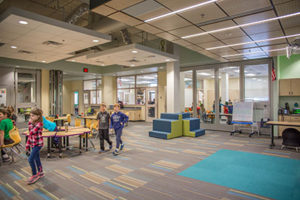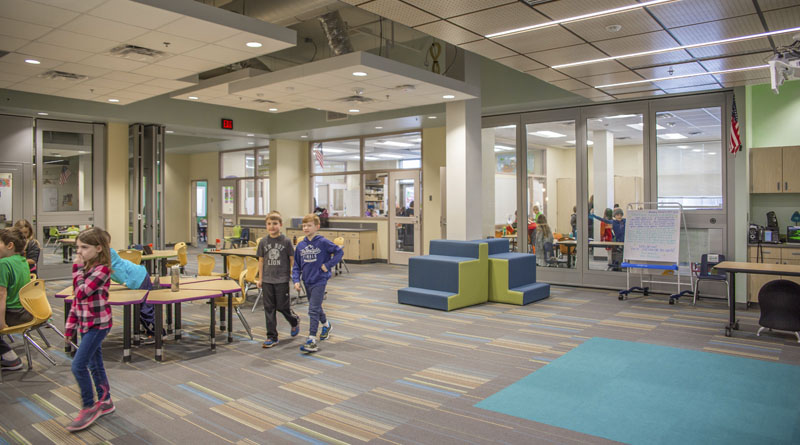Designing Adaptable Schools for Future Flexibility
By Vaughn Dierks
Schools should be durable, flexible facilities adaptable to future needs. To meet inevitable changes in programming and student population, districts should collaborate with their architects and planning teams to consider strategies for future flexibility without sacrificing quality.

Lakeville Schools in Lakeville, Minn., serving 10,800 students, gained tremendous value in long-term planning with an architect to design schools with this approach. Lakeville has partnered with St. Paul, Minn.-based Wold Architects & Engineers for 25 years to collaboratively design schools to meet current and future needs. As the community expanded rapidly, schools accommodated seamless additions and renovations thanks to forward-thinking designs. Demographic shifts, programming changes and technology have been addressed proactively through this process.
Here are seven strategies to consider that will help ensure the schools communities fund today will be flexible enough to support the educational programming of future generations.
1. Collaborate During Design
Architects should not tell a district what kind of school to build. Instead, the design process should emphasize collaboration and ownership by all stakeholders. Ultimately, when building users play a meaningful role in the design, they embrace results and pass their pride and values onto future generations. Architects, administrators, educators and students can take part in planning discussions early on to ensure buildings are customized to the unique needs of the communities they serve.
2. Design with Change in Mind
Needs change constantly during a school’s lifetime. We may not know what or how schools will teach in 50 years, but we know there will be differences. It is important that schools are not overdesigned to only address today’s needs. Designs that incorporate easily adjustable walls and flexible common areas can adapt to future programming requirements. A design defines small, medium and large group spaces that could have different uses than current needs but provide flexibility in clustered layouts.
3. Design for the Greater Community
An adaptable school serves more than the students currently enrolled. Buildings that serve the community have longevity. Community spaces accessible through zoning and compartmentalization for group functions within schools serve a broader constituency keeping it active and purposeful to all. Designs should accommodate direct, secure access to cafeterias, gyms, performance and other gathering spaces. Spaces can be used by youth, seniors, organizations, businesses, etc. — for a multitude of uses.
4. Invest in Quality Materials
A school is a long-term investment, so school leaders should consider durable, timeless, low-maintenance exterior materials. Discussions between all parties should work to strike a balance between current trends and long-term flexibility for both functional needs and aesthetics. Paint, flooring and signage will be replaced several times during the life of a building, and provide an opportunity to address trends, but the shell should withstand time as well as potential impacts related to structural, site and climate changes.
5. Consider Expansion
Unknown factors could dramatically change the population demands on a school. By planning for the possibility of expansions or additions, a district leaves open the ability to gracefully expand rather than disrupt a school with awkward, tacked-on spaces. Wold designed New Prague High School in New Prague, Minn., to expand by 500-plus students by using removable exterior wall systems at key expansion areas and identifying future expansions on all site plans.
6. Assume Technology Will Change
Technology is a constant challenge facing schools. Computer labs, followed by laptops in classrooms and now handheld devices have changed the way schools teach and classroom design has evolved. Schools need to support greater power and connectivity. Easily accessible infrastructure allows transitions with lower cost and less disruption. While no one can completely anticipate future technology, districts can prepare by specifying accessible and expandable robust mechanical, electrical and technology infrastructure.
7. Consider the Future of Energy
As renewable energy sources become more affordable, many districts choose to invest in systems that will reach break-even points and return savings within a short window. Solar power and geothermal system costs continue to lower and can bring long-term value to schools. Many districts are also joining community-based renewable systems. Mechanical system designs should plan for adaptability when price, technology and options make it feasible.
Discussing proactive consideration and implementation of these strategies into a school’s design will facilitate future adaptability. Working with forward thinking architects that plan for the future will allow districts to meet future needs seamlessly.
Vaughn Dierks, AIA, LEED AP, is a partner with Wold Architects & Engineers of St. Paul, Minn.

